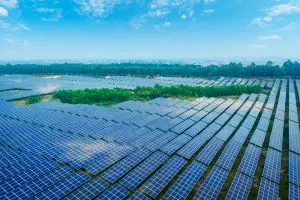Solar developers are planting native flowers and grasses near—or even in between—solar panels, addressing the twin problems of pollinator decline and climate change.
 Between a colorful array of wildflowers and the harmonious buzz of bees and butterflies circling overhead, the aesthetics alone of so-called pollinator-friendly solar farms may intrigue developers—making for easy marketing.
Between a colorful array of wildflowers and the harmonious buzz of bees and butterflies circling overhead, the aesthetics alone of so-called pollinator-friendly solar farms may intrigue developers—making for easy marketing.
But proponents say the incentives for incorporating native grasses and wildflowers throughout a solar plant extend far beyond flashy advertising.
Research published by Yale’s Center for Business and the Environment has found that pollinator-friendly solar can boost crop yields, increase the recharging of groundwater, reduce soil erosion and provide long-term cost savings in operations and maintenance. The research also found that by creating a cooler microclimate, perennial vegetation can increase the efficiency of solar panels, upping their energy output.
“I saw this as a potential way to smooth the path forward for increased solar development,” said Katie Siegner, an associate with the Rocky Mountain Institute’s Electricity practice who co-authored the Yale report, referring to the advantages the authors described.
Siegner said she hoped the findings could help debunk fears of solar projects supplanting agricultural land, by showing one way that they could help support local farmers and bring new social, environmental and economic benefits to rural communities.
The ability to build bridges with local communities is just one reason pollinator-friendly solar projects have become a growing trend in recent years among utilities, solar developers and companies that are looking more broadly to make a positive social and environmental impact while reducing their carbon footprint.
Bees and other pollinator populations have steadily declined in recent years, in part as a result of climate change, a trend that a 2020 study found could threaten U.S. crop yields and even pose risks to global food security.
Pollinator-friendly solar provides an approach to both the pollinator crisis and the climate crisis that is attractive aesthetically and economically, and potentially scalable. By planting a deep-rooted mix of native flowers and grasses around and even between solar panels that can provide abundant and healthy food for pollinators, developers can provide clean energy while also expanding pollinator habitat.
Just this year, the California nonprofit renewable electricity provider MCE began requiring solar farms that are located on arable land that supplies power to its members and partners to be pollinator-friendly.
The practice has also attracted oil and gas giants, many of whom have sought to green their public images amid public cries for climate action.
That includes oil major BP, which last year increased its stake in the solar developer Lightsource bp to 50 percent from 43 percent. Lightsource bp, which describes itself as a strategic partnership formed between Lightsource Renewable Energy and BP in 2018, identifies sustainability as a core part of its business and has recently attracted headlines with the construction of what the company is calling a “pollinator-friendly solar farm” in Sacramento County, California.
The $20 million investment and 16.5-megawatt project, called Wildflower Solar, came out of a power purchase agreement with the Sacramento Municipal Utilities Division, signed in November 2018. The project will support the division’s Neighborhood SolarShares Program, contributing to its broader commitment to deliver 100 percent carbon-neutral electricity by 2030.
“Lightsource bp has a strong commitment to implement initiatives that benefit biodiversity at solar projects throughout our portfolio,” said Alyssa Edwards, vice president of environmental affairs and government relations at Lightsource bp. Pollinator-friendly solar, she said, is one way the company seeks to “implement dual land-use strategies that can have meaningful environmental benefits.”
Leave a Reply